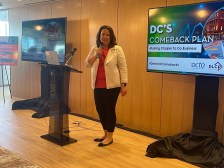Q&A: Business portal designer explains the philosophy behind the trend

Small businesses create two out of every three new jobs in the U.S. and employ more than half of the nation’s private sector labor force. They also account for a sizable share of local tax revenues and act as drivers for indirect revenues as residents arrive for new jobs and local populations rise. With this in mind, it’s no wonder why cities are looking to business portals to grow their economies.
Gaby Brink has become an expert in the craft of business portals. As the founder and chief designer of Tomorrow Partners, a design consultancy for governments and nonprofits, she has developed a set of best practices for municipalities looking to launch their portals. Business portals are websites that not only offer resources, but chart a path for every entrepreneur and small or medium-sized business owner to start or expand their companies. This support includes advice on zoning regulations, correct permits, timelines on licenses, proper renewals, and regulatory compliance issues.
Brink’s work is on display in San Francisco, where her team helped the city launch its first business portal, and also in Los Angeles, where she helped the city launch its portal on Sept. 14. Los Angeles Mayor Eric Garcetti praised the site’s architecture, an open source design developed by Brink’s Team, and the portal’s ability to smash economic barriers.
“Small businesses are the beating heart of our economy, and the L.A. Business Portal will make City Hall more responsive to their needs by giving them the help and support they deserve, all in one place,” Garcetti said.
In an interview with StateScoop, Brink outlined what her experience working with cities like Los Angeles and San Francisco has taught her about the business portal trend and why she thinks the technology is becoming an essential component of local governance.
StateScoop: How did you first begin working on city business portals?
Tomorrow Partners Founder Gaby Brink: A few years ago, with the SF business portal, the city kind of asked around in the Bay Area of who they should to do something really innovative with for small business. And several people pointed them to us and we ended up working with them. This was really our first introduction to working in government and it was also really the city of San Francisco’s first experience with using a human-centered design approach. It was a process where we said, ‘Great. We would be thrilled to work with you, but the methodology that we would bring to this challenge would involve the small business community, and in this process, we’d actually design from what we hear from them, rather than what’s needed in order to fulfill your project goals.’ Hats off to San Francisco. They said, ‘Awesome, that sounds great,’ and we went down that path and two things happened.
We went out in the field and sat down with small business owners in their places of work, which might be a restaurant or a workshop or a factory, and we interviewed them on what the process was like for them to start their business — not thinking about technology solutions at all — just asking about personal experience and the underlying stresses, obstacles, pain points for them to start a business.
And then, on the city side of it, we also engaged and brought together every single agency that a business owner has to interact with: the health department, building department, fire department, police department, and we brought them all in a room and we said, ‘OK, so think about this user journey of your customer, the business owner, and from your perspective tell us what you need from them in order for them to be compliant.’
That was actually quite transformative for them because for the first time ever they understood — kind of viscerally — that business owners don’t have a siloed experience [with one department]. They have one experience interacting with all the departments. What was nice about that is that it created a shared sense of ownership. And really what happens with these complex kinds of projects like this is that there is not one party that can do all of this. They basically have to aggregate content from all of these agencies.
StateScoop: Since that first experience, have you found any common needs between businesses in San Francisco, Los Angeles and the other cities you’re working with right now?
Brink: It’s interesting because it’s not what you might expect. the biggest pain point and difficulty that we heard over and over is when potential business owners would say, ‘I don’t know where to start, I don’t know what the steps are, I don’t know how much it will cost,’ or that the process was ‘like a big black hole that I step into.’ That is not a technology insight. That is a human insight, and this is what we’ve learned to design are business portal around.
So people come into this with typically three mindsets:
- They are either planning to start a business
- Or they have an established business that they’re managing
- Or they’re at an inflection point where they want to grow their business.
So as you come to the site, you’re only going to go down one of those three paths, and then whatever you experience down that path is all relevant to you. If you’re somebody starting up a nail salon and you don’t speak English or know where to start, you’re still going to find a path that’s relevant to you. But if you’re serial entrepreneur, you’re going to find things that are relevant to you, as opposed to people who’ve never don’t that before.
There are probably a hundred things you need to do, but we boiled them down to the 10 most common things. That is to create a business plan, chose a business structure, choose a place to operate your business, etc. That road map isn’t easily accessible anywhere. There are probably books that map this out, but it’s not common knowledge. In San Francisco, we used this to create the navigation for the site with the 10 things. What we’ve heard out of this is that it gives people sense of confidence that they can do this.
StateScoop: On the flip side of this, what are the common needs for city governments?
Brink: For the government, the biggest thing is that they want to make sure businesses are compliant. So that means that businesses have all the right permits and licenses to start their type of business.
There’s obviously a lot of tax revenue that comes from businesses being set up, and there are a lot of small and independent contractors and freelancers that think they don’t necessarily need a business license and they want to create clarity [that they do]. And there is also a huge cost to manage compliance. So, helping business owners understand what they need to do to be compliant and helping them understand why and when they need to have permits and licenses and to renew them is helpful. In an ideal world, if business owners knew how to manage this, that would reduce a huge cost on the city because they would require less folks to manage and enforce compliance.
Also, I think there is this idea that cities can level the playing field. San Francisco, Los Angeles, and most big cities have big immigrant communities. The fact that they have a resource that is not only translatable in any language but accessible on your phone is a huge win for cities because that means that they can have a thriving small business community.
StateScoop: How is user-centered design with a focus on customers prompting change and influencing governments?
Brink: It’s just so exciting. Cities are figuring out that user-centered and human-centered design is now becoming a requirement in many, many projects. And that’s just so exciting for us because it really changes the game. And it’s actually kind of a challenge for some of these big tech companies who are used to thinking about systems first, versus thinking about the user. It’s about making the systems invisible. For us, users shouldn’t even know [what company] they’re working with or know what platform they’re using. It should just be purely focused on citizen needs.
StateScoop: Do you see the use of open source business portals growing in the future?
Brink: The fact that San Francisco and Los Angeles collaborated on actually open sourcing their business portals is fantastic. Because what happens in government — and I guess in other sectors too — is that people are constantly rebuilding things that already exist. Here the hope is to really build on each others’ investments. And the idea is not to just say, ‘Here is a business portal. Now go deploy it in another city,’ but for the next city to say, ‘I have an idea that I can add onto this and then share it back with the community,’ so that whatever they add on can be leveraged in any other city. That’s the beauty of creating an open source community around a product — something that we hope to see expand in the future.






